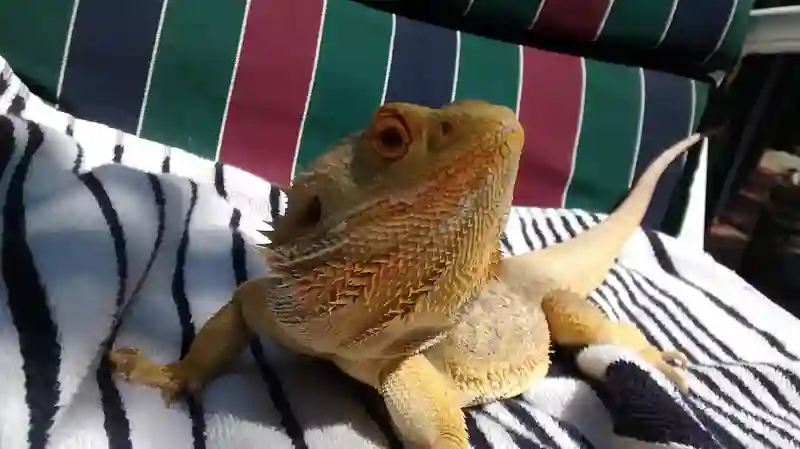Bearded dragons are beautiful and fascinating creatures that can make great pets. Unfortunately, they sometimes suffer from a common problem: dirt in their noses. While this is not usually a serious medical issue, it can cause discomfort and difficulty breathing for your pet if left untreated.
As a reptile expert, I know how important it is to find the right solution for dealing with this issue. Luckily, there are some simple steps you can take to help get rid of the dirt in your bearded dragon’s nose safely and effectively.
Fascinatingly, bearded dragons have adapted an ingenious way of cleaning their noses: by rubbing them against rough surfaces. This behavior helps to remove any dirt or debris that has become lodged in their nostrils.
Potential Consequences of Not Cleaning Bearded Dragon’s Nose Regularly
Not cleaning a bearded dragon’s nose regularly can lead to various health problems. Here are some potential consequences:
- Clogged nostrils: If the nostrils become clogged with shed skin or other debris, it can make it difficult for the bearded dragon to breathe properly. This can lead to respiratory infections, which can be serious and require veterinary treatment.
- Respiratory infections: Bearded dragons can develop respiratory infections if they are stressed, improperly fed, or kept in poor, cold, or dirty conditions. Symptoms of respiratory infections include sneezing, discharge from the eyes or nose, bubbles from the mouth or nose, unnaturally rapid or shallow breathing, open-mouthed breathing, decreased appetite, and lethargy. These infections can be serious and require immediate veterinary attention.
- Mouth rot: If a bearded dragon’s mouth is not kept clean, it can develop an infection known as mouth rot. Symptoms of mouth rot include swelling, redness, and discharge from the mouth, as well as a loss of appetite and lethargy. This condition can be serious and require veterinary treatment.
- Stress: Improper husbandry practices, such as not cleaning the bearded dragon’s nose regularly, can lead to stress, which can weaken the immune system and make the bearded dragon more susceptible to infections.
To prevent these potential consequences, it is important to clean a bearded dragon’s nose regularly. This can be done by giving the bearded dragon a warm bath and gently rubbing its nostrils with a toothbrush. If the nostrils are severely clogged, it is important to visit a veterinarian for treatment.
Tools Needed for Cleaning
To clean a bearded dragon’s nose, you will need the following tools:
- A soft cloth or cotton swabs: These can be dipped in warm water and gently wiped over the dragon’s skin, including the nose holes1.
- Tweezers: Tweezers are useful for removing nose plugs or sheds from the nostrils. They allow for precise grabbing of the shed and help in keeping the process clean.
Step-by-Step Cleaning Process
Here is a step-by-step guide on how to clean a bearded dragon’s nose:
- Prepare warm water: Fill a container with warm water. Make sure it is not too hot, as it can harm the dragon.
- Wet the cloth or cotton swab: Dip a soft cloth or cotton swab in warm water. Squeeze out any excess water to avoid dripping.
- Gently wipe the nostrils: Carefully wipe around the nostrils using a damp cloth or cotton swab. Be gentle to avoid causing any discomfort to the dragon.
- Use tweezers if necessary: If there are nose plugs or shed stuck in the nostrils, you can use tweezers to carefully remove them. Be cautious and gentle to avoid injuring the dragon.
- Monitor the dragon: After cleaning, observe the bearded dragon for any signs of discomfort or irritation. If there are any concerns, it is best to consult a qualified herpes.
Remember to always handle the bearded dragon with care and prioritize their well-being during the cleaning process.
Tips and Tricks for Preventing Dirt Buildup in Bearded Dragon Noses
Preventing dirt buildup in bearded dragon noses is important for their health and well-being. Here are some tips and tricks to help with this:
- Regular Cleaning: It’s important to regularly clean your bearded dragon’s nose to prevent dirt buildup. This can be done by gently wiping the nostrils with a damp cloth or cotton swab.
- Provide a Clean Environment: Ensure that the bearded dragon’s habitat is clean and free from excessive dust or debris. Regularly clean the terrarium and remove any uneaten food items to prevent the growth of bacteria or fungus.
- Avoid Loose Substrates: Be cautious with the type of substrate you use in the terrarium. Loose substrates, such as sand or wood shavings, can easily get into the bearded dragon’s nostrils and cause irritation or blockage. Opt for safer substrates like reptile carpets or paper towels.
- Maintain Proper Humidity: Bearded dragons require a specific level of humidity in their environment. Ensure that the humidity levels are appropriate, as excessive dryness can lead to dry nasal passages and increased dirt buildup. Use a hygrometer to monitor humidity levels and provide a humid hide or mist in the enclosure if necessary.
- Regular Vet Check-ups: Regular visits to a reptile veterinarian are essential for the overall health of your bearded dragon. During these check-ups, the vet can inspect the nostrils and provide any necessary cleaning or treatment if there are signs of dirt buildup or infection.
Remember, if you notice any signs of respiratory distress, such as wheezing, discharge, or difficulty breathing, it’s important to seek veterinary care immediately.
Conclusion
Keeping your bearded dragon’s nose clean is an important part of ensuring their overall health and well-being. By understanding the problem and following these tips and tricks for preventing dirt buildup, you can help keep your pet healthy and happy for years to come.
Remember to give them regular check-ups with an experienced veterinarian to catch any potential issues early on. Your attention will keep them happy!


